What needs to go into a marketing communications action plan to survive a recession?
In March 2020, we saw global brands like Apple, Nike and Starbucks closing stores around the world and posting Coronavirus advisories to their websites and social networks. Since then, many businesses and individuals have seen their fortunes transformed by the COVID-19 pandemic and following recession.
By May, we saw many countries moving from lockdown to re-opening some businesses, with new measures in place. But this wasn't enough.
By mid-June, the impending global recession had been confirmed, the worst economic hit since WWII. This forecast by the World Bank demonstrates a GDP drop in 2020 for all regions, Latin America and the Caribbean being hit the worst and East Asia Pacific the least.
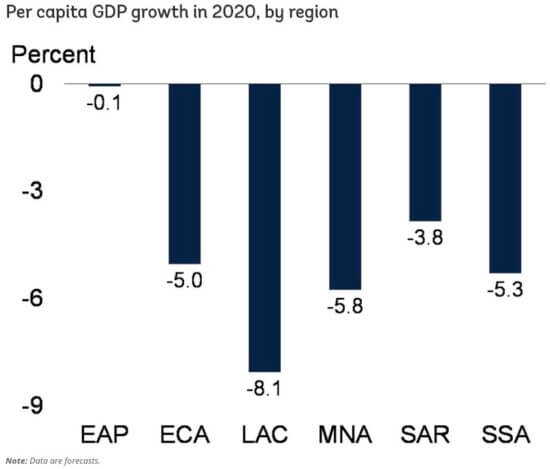
To help consider the priorities and options from a marketing perspective we have published this free recession marketing action plan guide to help marketers consider their next steps. In this article I review some of the main considerations.
Download our Free Resource – Creating a marketing action plan for a recession
With changes in consumer in consumer spending, it becomes vital to rapidly think through new alternative approaches to prioritize marketing activities with the biggest potential. That’s where this guide aims to help, by presenting a checklist of 45 ideas to review.
Access the
The huge pressure of responding to a recession on marketing budgets, campaigns, and marketers
The CMO COVID-19 special report confirmed that 84% of marketers confirm they have ‘improvised to generate new marketing strategies during the pandemic’, with 42% shifting resources to new products or offerings as plans take a back seat.
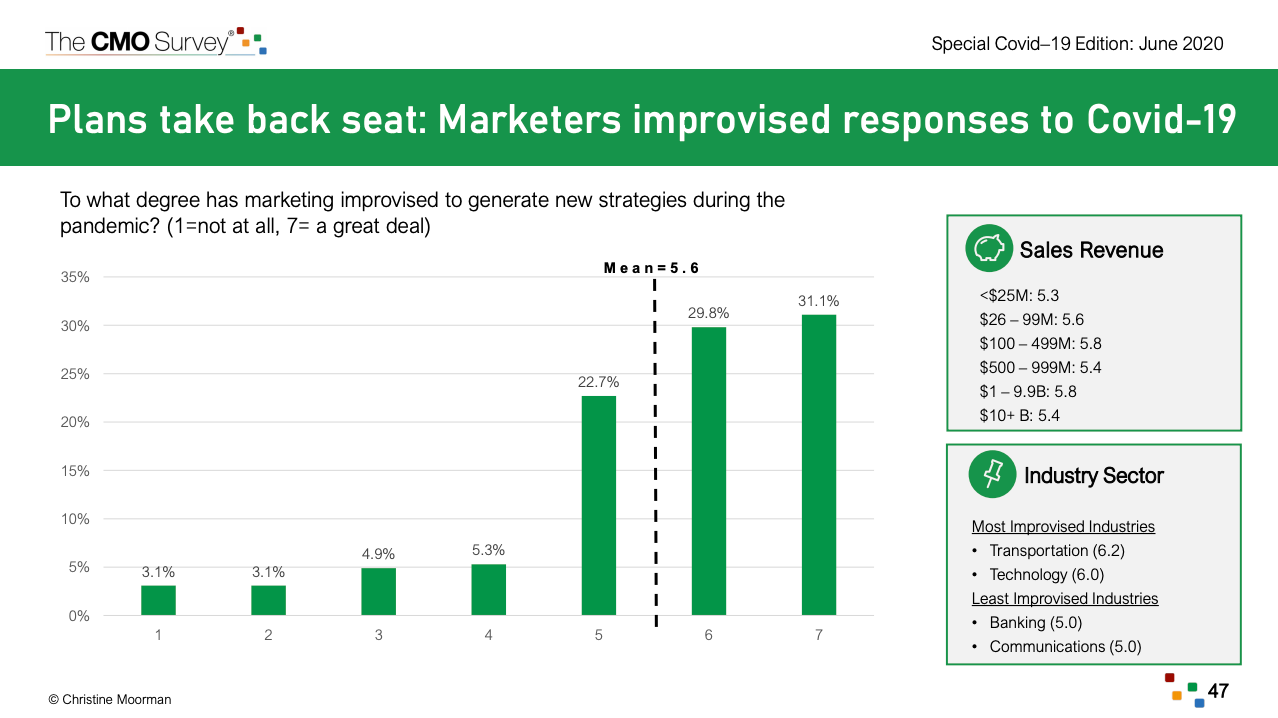
Your recession-beating marketing action plan
Anyway, you will be painfully aware of this already, so let’s get to it. I’ve structured these ideas for you to review using the 'plan' part of our RACE marketing planning system.
RACE is designed to be relevant to most businesses for who digital multichannel communications are important, including both businesses that sell online and those that use digital channels to create awareness and brand preference which encourages people to work offline. It's not designed for these times (what is?), but it does give a structure to consider ideas.
We’ll look at different ideas across the customer lifecycle shown below:
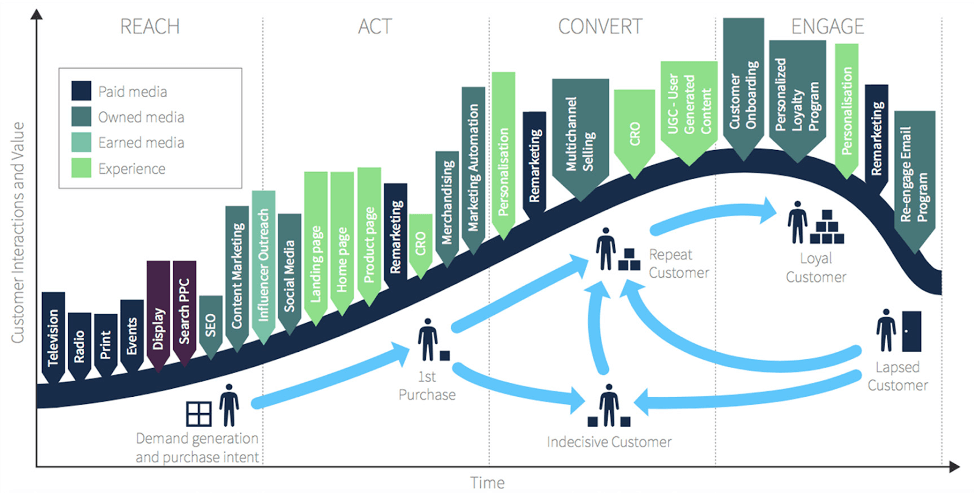 I was prompted to write this article and the accompanying guide since I was talking earlier in the week to a group of small business owners and marketers in the tourism and hospitality sector in the south of England.
I was prompted to write this article and the accompanying guide since I was talking earlier in the week to a group of small business owners and marketers in the tourism and hospitality sector in the south of England.
Tourism destinations and their accommodation, entertainment and venues, will obviously be one of the hardest-hit sectors in the current market. In some industries, like aviation, it's unfortunately inevitable that some staff may need to be put on unpaid leave and marketing campaigns curtailed. But for others, where there is still consumer demand, new approaches can be considered.
Does this sound overdramatic? Maybe it’s because I’m writing about this sector, who are in a battle for survival (their words). However, all industries can benefit from considering low cost and no cost inbound marketing techniques.
About these data-driven tools and techniques
We created Smart Insights to help share marketing best practices. Two key pillars of our approach are to encourage marketers to use a more planned approach to their marketing and to harness the power of analysis to test, learn and refine your approach - it’s why we’re called Smart Insights.
Download our Free Resource – Creating a marketing action plan for a recession
With changes in consumer in consumer spending, it becomes vital to rapidly think through new alternative approaches to prioritize marketing activities with the biggest potential. That’s where this guide aims to help, by presenting a checklist of ideas to review.
Access the
Both of these techniques have the benefit that they’re free, all that’s needed is a change of mindset and changing your allocation of time through planning to focus more time on planning, testing and improving.
We know from our research that many businesses and particularly smaller businesses don’t tend to plan. It’s arguably less necessary, but now short, focused plans are more important than ever. If this is your situation, it’s really a change of mindset
Plan - defining your marketing strategy and action plans
1. Create action plans to prioritize your resources
Our Managing digital marketing in 2020 research shows that many businesses don’t naturally plan.
This chart shows that around half of companies don’t have a dedicated digital marketing strategy and this was similar for the businesses in the workshop. Many didn't have any formal marketing plan.
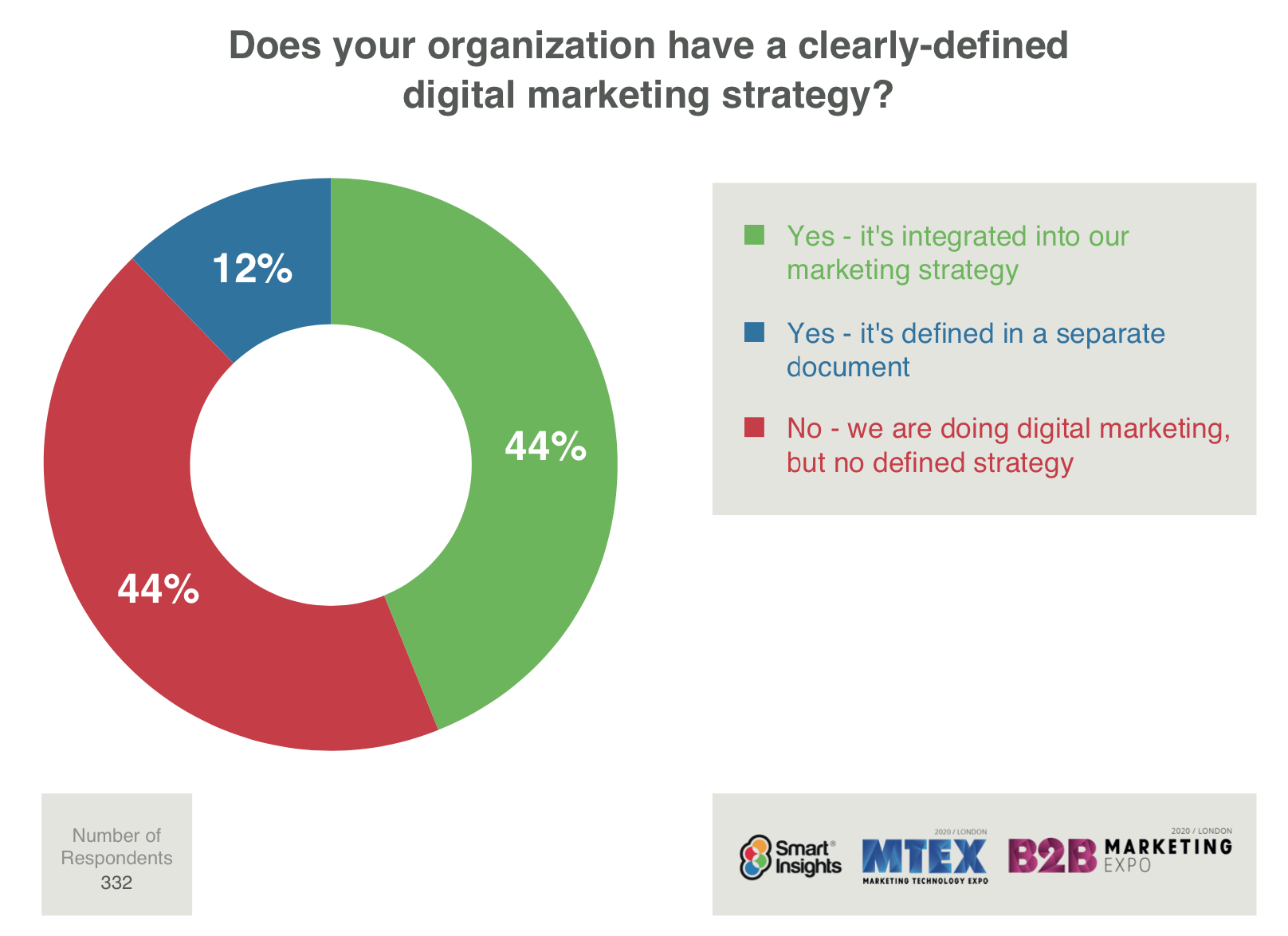
In any recession, a plan becomes even more important since you will have to revise your forecasts and really prioritize the most effective techniques. Larger businesses may develop business continuity plans, but for smaller businesses, having more flexible actionable plans are important. In this article, I’m going to cover a lot of practical ideas and hopefully, they will prompt some ideas with you that you can test, but they need to be scheduled in.
In the workshop, I talked about our recommended 90-day planning technique which will help you plan and monitor all the tests you select across RACE. For example, in one quarter you may test your home page effectiveness, in another, update your navigation.
Outpace your competition in a challenging SME market
Access a complete marketing survival kit to grow your business during a recession
Get Results, Fast
2. Sort your analytics!
You can’t start your analysis and data-driven marketing without this. By sort, I mean customize your analytics so you can tell whether interactions with your website are really generating value for the business and you. In the workshop we talked about setting up the right types of goals and putting values against them, which is more challenging when you’re not selling online, but perfectly possible. By defining value for your goals you will then be able to much better understand the effectiveness of your content in achieving goals (though Page Value) and the effectiveness of your media investments (through Goal value per visit).
For example, Google's Demo account data shows how Page Value provides a good way of comparing different page types to see how they support conversion - here they vary quite widely. You can work on pages that are less effective.
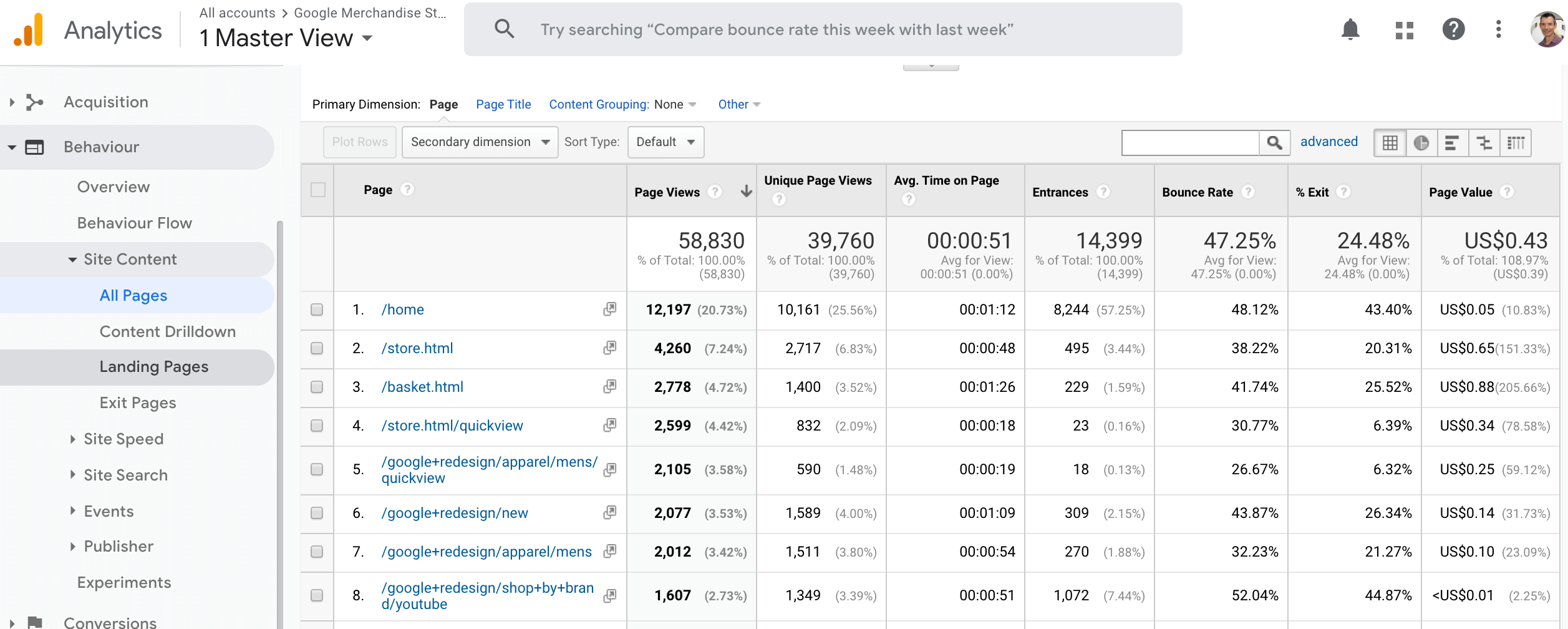
We also discussed the need to use Google Tag Manager, concluding that it’s not essential for small businesses, but valuable if you are going to set up more complex goals and remarketing lists.
3. Get the balance between campaign and always-on activities right
In smaller businesses, there is a natural tendency to focus on campaign activities to generate awareness and demand. Thinking longer-term and moving from campaign to always-on marketing activities that support the long-term growth of the brand makes sense in the face of declining budgets.
The latest E-Consultancy COVID-19 stats roundup reports that UK retail footfall continues to rise in August, but remains 32% lower year-on-year. Much of this footfall seems to come from purchasing 'essential items' shopping (70% of UK shoppers made a trip out to do so during 12-16 August). Whereas fewer UK shoppers are regularly going out and about for non-essential items (25% of UK shoppers during the same period).
This graph from the Office for National Statistics shows how high-demand products have fluctuated in price over this time period.
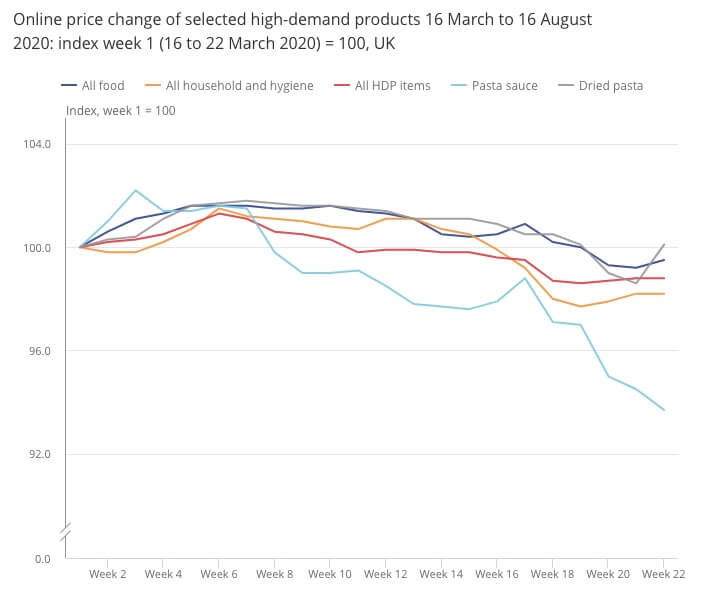
To succeed in digital marketing also means tapping into existing demand as people search for your types of services or review alternative providers in listings. Gaining good ratings and visibility in Trip Advisor is important in the tourism sector, of course. Always-on also involves using automated marketing activities for email marketing and retargeting, which we’ll come back to.
Use tools like Google Trends, Keyword planner and Google Search Console to see the latest changes in behaviour.
4. Review the gaps in your always-on marketing.
The visual above shows ALL the activities you could potentially deploy to integrate your paid, owned and earned media activities. Very often there are gaps in what could be used, as this example shows. Perhaps you could improve your middle or bottom of funnel content, or you could improve your email welcomes, we’ll return to these also.
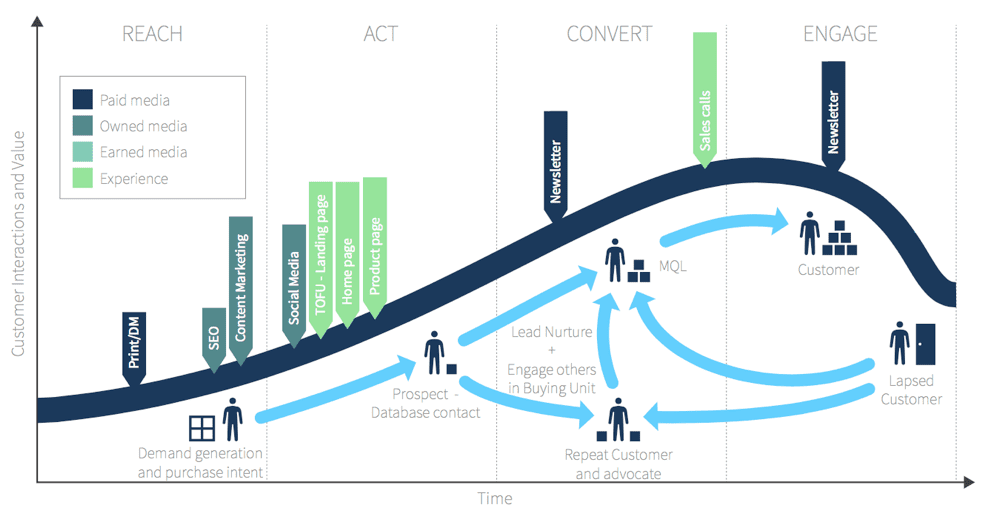
5. Review your STP
Segmentation stands for Segmentation, Targeting, Positioning. it’s well-known as being at the heart of focusing your marketing appeal on key audiences you’re targeting. You can read more in our free marketing models download.
In times of recessions, the balance between different audiences and markets may change. An obvious example in destination marketing, is that there will be more local companies.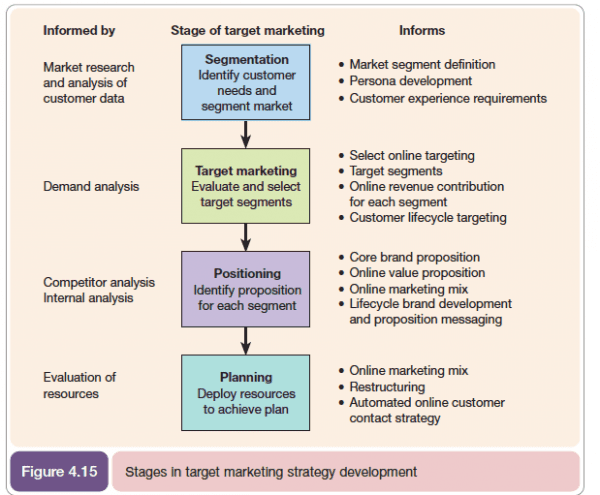
6. Refine your personas
Effective marketing should always start with the customer and understanding customer preferences and perceptions - and how they change through time. Personas are a great way to share your understanding of customers. So put more time into creating effective persona - our persona template gives a framework for the essential information in the ‘perfect persona’. Including content mapping is an essential way to make your personas more actionable as we’ll show with the example in the ‘ACT’ section.
7. Positioning - re-examine the strengths of your brand
Introducing research about how companies use digital media and technology, Philip Alford who invited me to speak for businesses who were members of the local tourism association, starting the day by stressing that you have to start with your brand and how the customer perceives it alongside other businesses.
Reviewing your branding is key in times of a recession, here we're focusing more on marketing communications, but I recommend reviewing the 8 recommendations for marketing in a recession from Harvard Business Review for more general advice.
8. Improve your Digital value proposition (DVP)
In my books, dating way back to 2000, I recommended marketers review their ‘OVP’ or Online Value Proposition as part of their strategy. Clearly a website needs to communicate the core brand offering and brand personality, but digital gives great opportunities to add value to an audience and so develop brand preference and support purchase intent.
In the workshop, we looked at how this destination had thought through its DVP, by providing lots of options under it's 'Visit Us', this is often just a single page.
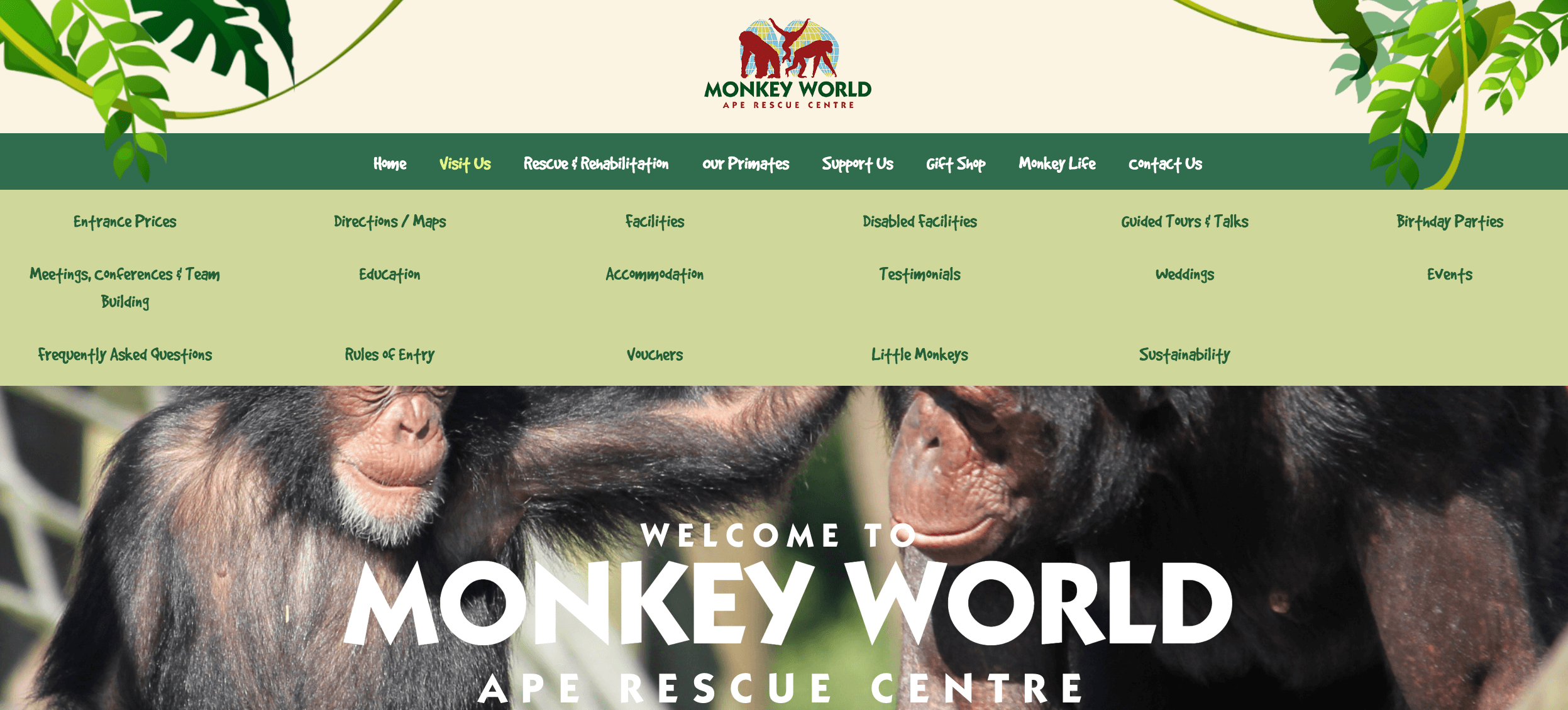
In another example, this wedding venue has multiple pages describing its wedding options. By creating more detailed content and then interlinking it can help the offer become more appealing. Plus it has the benefit of making the site more effective in organic search when people are searching for this content. Simply put, the more content you develop that meets consumers' interests, the more visits and higher conversion you should see.
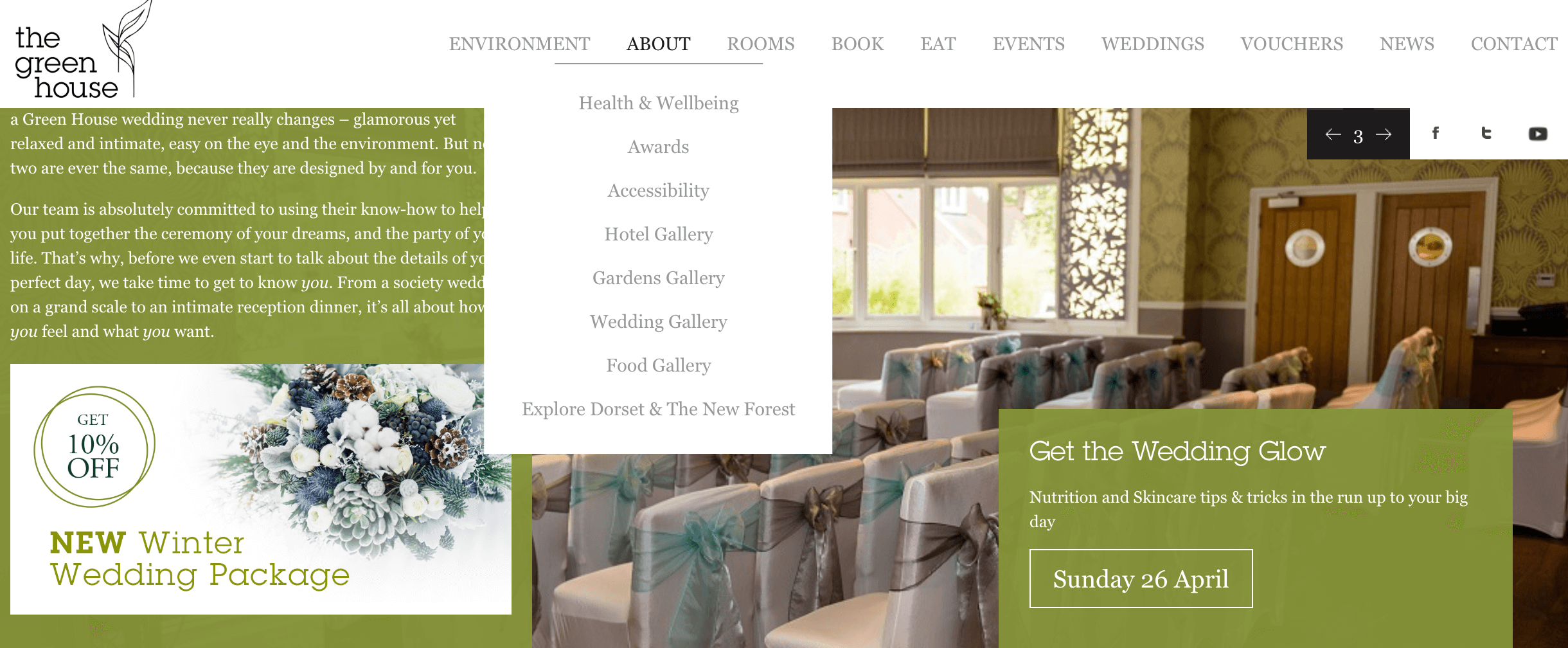
9. Understand changed customer preferences
Personas should be based on research, but they may not reflect changing concerns of the time, so look to use published research or conduct your own research to see how consumer spending power has changed.
For example, the shift value attributed to e-commerce in all persona types during the pandemic has had huge repercussions for both online and the high street.
While online sales fell back 7% in July, they still very much dominate retail landscape, with online shopping 50% up on figures from February. As physical stores began to open again, July saw an overall year on year increase for retail of 3%, but for some retailers this is not enough.
10. Benchmark communications against competitors
A simple, practical tip. Keep a closer eye on your competitors than ever. In the panel, I explained how I keep an eye on our competitors and publishers we follow using Twitter lists which can then be followed as streams in Hootsuite. It’s a geeky tip, but Matt, one of the panellists, used exactly this technique in Tweetdeck to track communications for their clubs and restaurants and then compare and improve them relative to competitors.
We also recommend setting up Talkwalker or Mention as simple free brand alerts that is more powerful than the better known Google alerts.
11. Update your brand tone-of-voice
Speaking with a common, appealing voice can be difficult across all of the different channels, so developing a common agreed approach for people writing across. See these brand tone-of-voice examples for quick ways to reconsider your approach.
12. Smarter discounting
This technique can be applied in many sectors that need to be reconsidered during times of recession since consumers have less cash and competitors may offer deeper discounts. We discussed options for testing discounts for tourist attractions and bars and clubs and doing it in a creative way. For example testing 10, 20, even 30% discount, what works best in the customer journey. We noted that it wouldn’t work for some price points and some audiences. This is where being creative comes in since.
13. Review your martech stack
The research we discussed looked at what could be included in our martech stack. See our essential digital marketing tools and free guide for examples of types of tools you can need. As one example, I asked how many people were AB testing their website pages. While some people were testing their email creative using AB testing, few had used Google Optimize to test. This is a tool that is relatively simple, so you can get started with limited agency support.
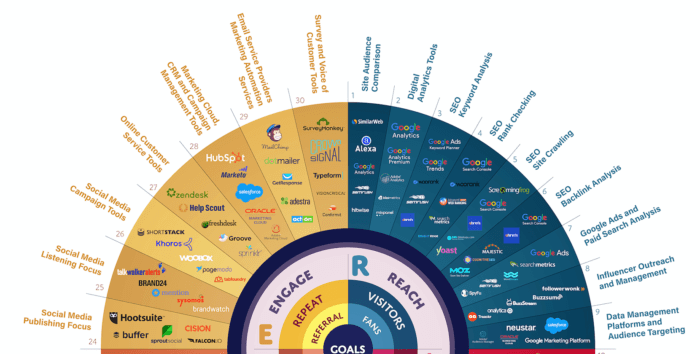
I’d also say that using multiple cloud-based marketing tools can be expensive - some estimates put it at 15 to 25% of the marketing budget. There are potential savings here, either by consolidation to a single marketing cloud solution or stopping using tools you don’t use so much.
14. Review your marketing resourcing
Many businesses will be looking at the cost vs benefit of how they use consultants and agencies. Many of the businesses I spoke to, were using consultants as specialists who knew the intricacies of digital and had set them up.
15. Encourage learning
Consider the skills gaps within your team - which are most needed to prioritize. One Business Member we’re working with has recently conducted this and have concluded that it's the fundamentals of copywriting and proofing that is the number one.
Smart Insights are all about online learning of digital marketing using relevant examples and plans, not just showing the features of systems. Through this blog, we offer many free resources or you can try our list of free online training marketing courses to improve your digital marketing skills.
Download our Free Resource – Creating a marketing action plan for a recession
With changes in consumer in consumer spending, it becomes vital to rapidly think through new alternative approaches to prioritize marketing activities with the biggest potential. That’s where this guide aims to help, by presenting a checklist of 45 ideas to review.
Access the





 I was prompted to write this article and the accompanying guide since I was talking earlier in the week to a group of small business owners and marketers in the tourism and hospitality sector in the south of England.
I was prompted to write this article and the accompanying guide since I was talking earlier in the week to a group of small business owners and marketers in the tourism and hospitality sector in the south of England.












